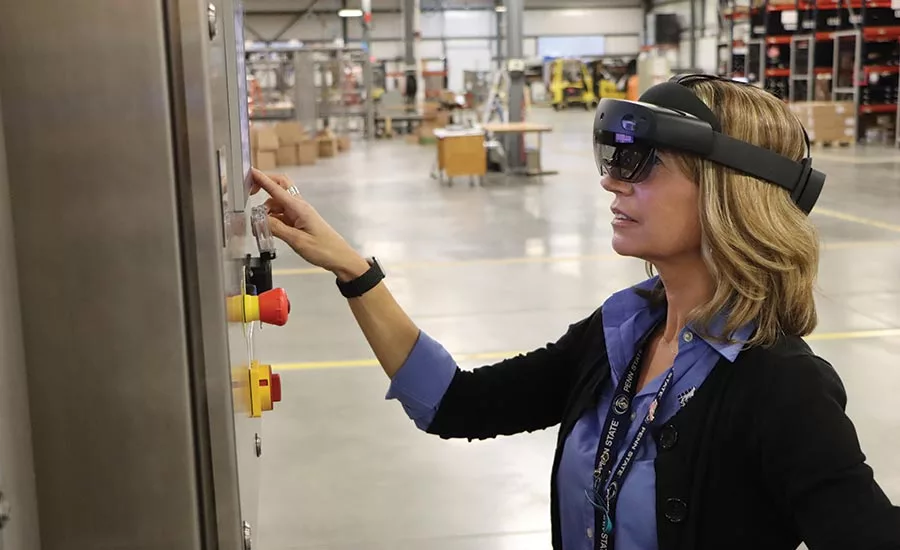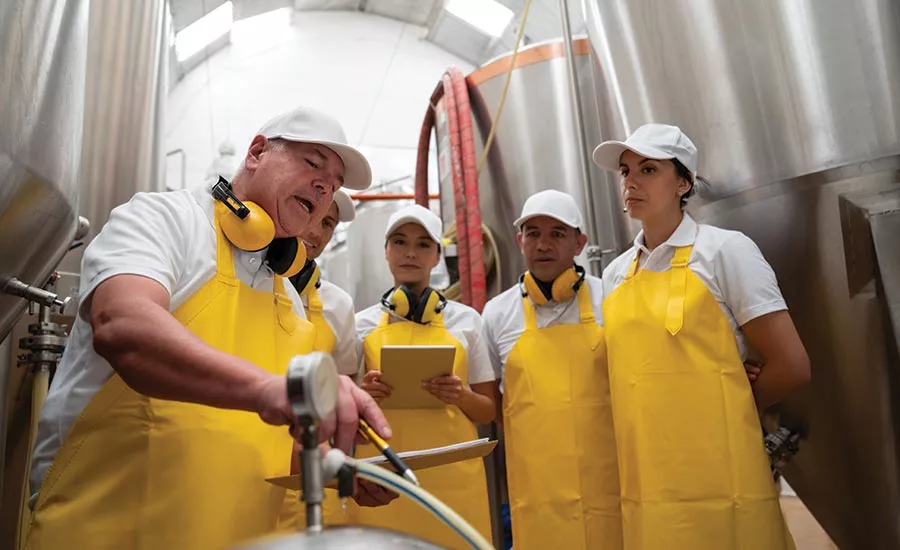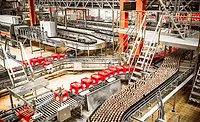Pandemic requires new employee training methods
Some new training methods are here to stay

JLS Automation uses Microsoft’s HoloLens technology to conduct virtual training. The headset allows remote trainers and support personnel to see what the person on-site sees and communicate with them.
Photo credit: JLS Automation

Pre-pandemic training often involved groups of employees in a classroom or on a factory floor. But with COVID policies restricting that option, processors have to find new ways to conduct training effectively.
Photo credit: Getty Images/andresr
As the COVID-19 pandemic has continued to disrupt operations across the food and beverage industry, processors find themselves balancing a number of training challenges.
Surges in demand and labor shortages due to illness have led to the need for more hiring and training to get new employees up to speed. Existing employees have had to cross-train to cover employee outages or added production demands. Regulatory and food safety training has had to continue to meet government and customer requirements. And new construction, commissioning and equipment start-up has continued, because food and beverage plants are the definition of essential businesses.
To meet all of those needs, processors are turning to a number of new tools to ensure training is accurate, timely and effective. But what they’re learning is that many of the tools adopted out of necessity offer benefits that will last even after operations return to normal. Some of those tools were already being used in certain applications or locations; others are new or being used in new ways. What they have in common is they offer processors a way to break out of the traditional model of bringing a bunch of employees together and sitting them down in a classroom setting for days at a time.

“I honestly believe that augmented reality has changed the way in which we look at things from both a support and maintenance perspective as well as training and everything else.”
–Hugh Roddy,
vice president of global engineering and product management, Chobani
Consider the example of Chobani, which has turned to a number of virtual tools to help with maintenance, commissioning, start-up and training during the pandemic. One of the key tools is augmented reality, which has given the company the ability to have a plant employee wearing a headset that allows a remote support person to see what the plant employee is looking at and communicate with them.
“I honestly believe that augmented reality has changed the way in which we look at things from both a support and maintenance perspective as well as training and everything else,” says Hugh Roddy, vice president of global engineering and product management, Chobani. “So we won't need to have people come on-site all the time. We can do virtual training on the plant floor. We can train our operators on operating the machine because this actually allows us to record what's been done.”
That’s one example. There are numerous others, and they’re showing that while the pandemic is forcing processors to adopt temporary solutions, some of those solutions are here to stay.
Remote access
The most fundamental training challenge facing food and beverage processors right now is envisioning a new model. Traditional training has long included elements of virtual training, such as sessions being recorded for on-demand viewing or mobile apps allowing for training on the plant floor. Tools such as Alchemy’s Playbook allow processors to develop their own training and have the course available on a smartphone or tablet so that trainers can take trainees to the plant floor and walk through training on processes or equipment.
But overall, training has consistently involved moving either the trainer or the trainees from Point A to Point B, then meeting in person. With travel restrictions and safety concerns being top of mind during the pandemic, that model doesn’t really work. If your company has a travel ban and you need to train 25 new employees in three different facilities spread out across the country, you can’t just fly them all to one location for training or have the trainer go to them.
Alchemy’s Archie Barrett, vice president of product management, says the company saw this trend develop early on in the pandemic. Before the pandemic, about 73% of the company’s more than 2 million monthly training records were being conducted in groups. By April and May, that number had already dropped to 62% as processors were dealing with restrictions on travel and group gatherings.
“They were challenged with keeping people separated, as they still are today,” says Barrett. “’We can’t be in rooms together, we’re going to have to figure something out.’”
It’s not just companies that focus on training as their core business that had to adjust to that trend. JLS Automation, a manufacturer of robotic packaging solutions, has been working with remote solutions for some time, but has seen interest in those solutions grow since the pandemic hit. The company began using Microsoft’s HoloLens technology for remote support several years ago, and that was the primary focus for how the technology was used. But it’s been used to offer training for some customers before the pandemic, and the existing knowledge of how to conduct virtual training has allowed the company to adapt quickly to the new demands.
“I almost feel like it's more effective because you literally see what they see,” says president and CEO Craig Souser. “When you're standing next to somebody, you could be looking at something and not understand why they're not seeing it literally. But when you're looking through the lens with them, you see what's in their line of sight. So if they're looking at the wrong terminal strip, you know it.”

“When you're standing next to somebody, you could be looking at something and not understand why they're not seeing it literally. But when you're looking through the lens with them, you see what's in their line of sight.”
–Craig Souser,
president and CEO, JLS Automation
Augmented reality’s ability to provide remote support and training personnel video and audio of what plant employees are doing and what they’re looking at opens up a number of new possibilities. As Souser says, it gives remote personnel the ability to understand what a plant employee is looking at and be on the same page with them. Beyond that, AR also allows for remote personnel to give guidance and instructions to plant employees who are trying to troubleshoot a piece of equipment or learn how to use or maintain it.
“They could be looking at a screen and they could say, ‘Hey, turn your head to the right or the left to look at that particular device,’” says Roddy. “They point their hand over on that screen and they can match the screen of what I'm looking at and make me look at it and say, ‘Hey, that's what you want me to touch.’ They're actually integrated with me virtually on the plant floor.”
A new model
As demand for food and beverage products surged, processors were faced with multiple challenges to their ability to keep up. They had to have enough people to meet production demands while also keeping those people safe. That forced some rethinking of their traditional hiring and onboarding methods.
“We actually had to staff up quite a bit, but what we were challenged with was we weren’t bringing people on site,” says Jodi Haggith, People Manager at Bonduelle’s Strathroy, Ontario, Canada plant.
The company revamped its interview and hiring process. Recruiters would do the initial culling of applicants and create a shortlist of candidates. The company produced videos of the work environment and what jobs would entail, then sent them to short-list candidates to replace the traditional plant tour that interviewees would receive. Strathroy is home to a number of automotive plants, and Bonduelle’s work environment is wet and cold, which potential employees may not be used to if the automotive plants are what they’re used to or if they’re applying to Bonduelle for their first job.
The videos also helped to narrow down the pool of potential candidates, because some candidates decided they didn’t want to work in that kind of environment. By getting those decisions based on a video instead of after a candidate had come in for an interview and taken a tour, Bonduelle was able to limit the number of people coming into the plant and save time throughout the hiring process. Now, candidates coming in for an interview already know the environment and are more committed to working there than someone who was coming in without that knowledge.
The company did have to adjust some of its processes based on feedback from employees and potential new employees. While the virtual tools it used for hiring and onboarding were effective, interviews via video calls and in-person interviews where candidates and interviewers were wearing facemasks made it harder to pick up on non-verbal cues and make employees feel comfortable with their new coworkers.
“What I found really challenging through this whole process was that we now had employees that aside from seeing them on camera, we didn’t see their face,” says Haggith. “It was definitely challenging to make them feel like they were part of the group when they arrived.
“It helped us appreciate how important that engagement piece is to a new employee. As much as we thought ‘wow, this is cool, it saved us a bunch of time,’ there was something missing.”
It also was tough to integrate new employees with existing employees due to safety concerns and trust taking time to build. As new employees came in, existing employees expressed concern about not knowing how the new employees were complying with safety procedures for themselves and their families.
“We have pretty tight work teams, so everyone knows what everyone is doing, where they’ve been, what their family’s been up to,” says Haggith.
To combat this, the company focused on heavy training on its safety protocols, including face shields and masks, gloves and hand sanitizer.
It wasn’t just processors who had to adapt to a new training model. Advanced Technology Services (ATS), which provides maintenance and MRO services, has long had a robust training program, but had to overhaul it to meet the new demands caused by restrictions on travel and gatherings.
“It was a bit of a shove into the pool with COVID,” says Tate Pearson, ATS senior director of operational excellence, who oversees the company’s technical training. “Historically we had always done that through traditional class kind of work, going out to students either in their factories or bringing them to one of our technical training centers.”
The company had used simulator kits for face-to-face training, so it was familiar with some aspects of virtual training. But it had to adapt its training model to remote training sessions through videoconferencing.
“There was certain content that was easily transferrable; there was other content we had to tweak, knowing the instructor and the student were not actually in the same physical space.”
Going global
Not every food and beverage processor has facilities in dozens of countries worldwide. But it’s entirely possible that even a small specialty processor has equipment from the other side of the country, somewhere else on the continent or somewhere overseas. Travel restrictions are a new concern due to the pandemic, but even under normal circumstances it can be a logistical challenge to get a trainer from Germany to Colorado.
This has been a challenge food and beverage processors have dealt with for years, and remote and virtual training has been an option for some time. But the pandemic has made that option a necessity.
As Roddy says, the augmented reality options allow for long-distance training. People in Chobani’s New York facility can use the headsets to train employees in Idaho. Employees or vendors can record the training sessions to be archived for future use as well.
“They can do refresher courses and go over the same videos without having to bring someone back on-site and we just ended up with a lot of training videos that would be used by using these headsets,” says Roddy.
Thermal Fluid Solutions, a UK-based provider of thermal fluid system support and maintenance services, used to do all its training in person, says managing director Richard Franklin. But the company has been working to accommodate requests for easily accessible training because of compliance requirements.
“The biggest shortfall in face-to-face is being able to access all the number of people you need to because of operations or working shift systems,” says Franklin. “It's very, very difficult to get to all of the people all of the time.”

“The biggest shortfall in face-to-face is being able to access all the number of people you need to because of operations or working shift systems.”
–Richard Franklin,
managing director, Thermal Fluid Solutions
With the pandemic, remote training became a requirement, so the company was able to adapt and expand its remote and on-demand offerings. The training takes place online, then results are reported to corporate or site locations to track who has and hasn’t been trained on the risks associated with thermal fluid systems.
“We can now actually hit good numbers that we were almost incapable of hitting—that's not through incompetence—it's just you couldn't find all of these people, but now we actually can,” says Franklin.
The new normal
As food and beverage processors look forward, there are of course a number of questions about when the world will get back to normal, and what “normal” will actually mean. Training will be a big part of that, because the pandemic didn’t necessarily create new methods of training as much as it expanded the use of solutions that were already available.
For processors who are looking for the most effective and efficient ways to train employees, whether they be new or existing hires, embracing the technology options and customizing them to their specific needs can help solve numerous challenges, both technical and logistical. As is the case with so many other elements of plant operations, processors are learning that what worked before may still work now, but there may also be a better way.
“It's bizarre, but I do think actually think that it's causing us to make best use of our resources and I think there's lessons learned,” says Franklin. “And I'm hoping that we don't go back to the bad old habit of just jumping on a plane or jumping on a car just because that's the way we did it.”
For more information:
JLS Automation, https://www.jlsautomation.com/
Advanced Technology Services, https://www.advancedtech.com/
Thermal Fluid Solutions, https://www.thermalfluidsolutions.com/
Looking for a reprint of this article?
From high-res PDFs to custom plaques, order your copy today!







